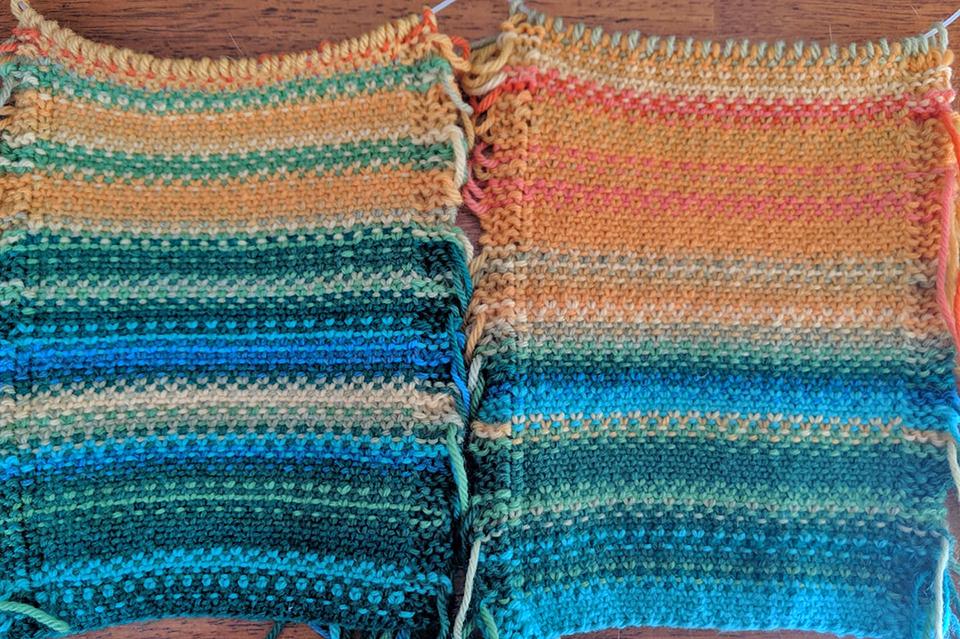
In-progress Tempestries for Arches National Park/Laura Patterson.
Tempestry Project: The Tempestry Project is an ongoing collaborative fiber arts project that presents climate change data in visual form through knitted or crocheted artwork. -- Wikipedia
I remember when my very first Tempestry arrived in the mail. Pulling out the list of instructions, I held the bright, tightly wound balls of yarn in my palm, contemplating the data they would eventually reveal to me. A science and fiber project, each row of each Tempestry represents the high temperature of a single day. The finished product - 365 days, 365 rows - unfurls to the size of a scarf, but represents an entire year of temperature data. An idea dawned: what if knitters around the country knitted Tempestries for their favorite national park?
The Tempestry Project
"I'm looking forward to seeing the National Parks Tempestries displayed. It will, of course, make me think about climate change, which I contemplate each time I knit, but I also feel a kinship with all the other folks who are working on this project." ~ Barbara Fahey Schmitz, North Carolina.
The Tempestry Project founders - Emily, Justin, and Marissa - liken each Tempestry to a bar graph, with January at the bottom and December at the top. "All Tempestries use the same yarn colors and temperature ranges," they write on their website, "creating an immediately recognizable and globally comparable mosaic of shifting temperatures over time."
In an email, Emily, Justin, and Marissa describe the genesis for the Tempestry Project writ large: "During that winter following the presidential election in 2016, we started seeing more and more articles about concerns that the incoming administration would purge climate research data and language from government websites such as NOAA and the EPA."
The trio continued: "We joked, and then stopped joking, about needing to return to older more reliable forms of data storage, like cuneiform tablets or ancient tapestries. These concerns have unfortunately been proven accurate, and the Tempestry Project has grown into not simply permanent data storage but rather a conversational bridge between hard data and personal lived experiences."
When considering their own Tempestry patterns, the team wanted something replicable across both sites and crafters, "a true global mosaic."
"At first," they explained, "We settled on a temperature range spanning 0 F to 100 F, but quickly realized that our vision was skewed by living in a very temperate corner of the world (we seldom get below freezing and seldom over 75F!), so we expanded it to -30 to 121+."
To make the projects as similar as possible in terms of materials, they had to find a line of yarn with enough colors to accommodate the entire range of temperatures, but didn't cost too much. "KnitPicks fit the bill," they write, "though even then it took us weeks to settle on colors that worked. Overall, it took about three months from the germ of the idea to our first finished Tempestry - which was for Deception Pass, Washington State, 2016."
To date, they create more than 500 Tempestry kits every year to mail to crafters across the world. Many of the resulting artworks are used in library, museum, and art show displays to highlight changing climate in some of our most beloved landscapes.
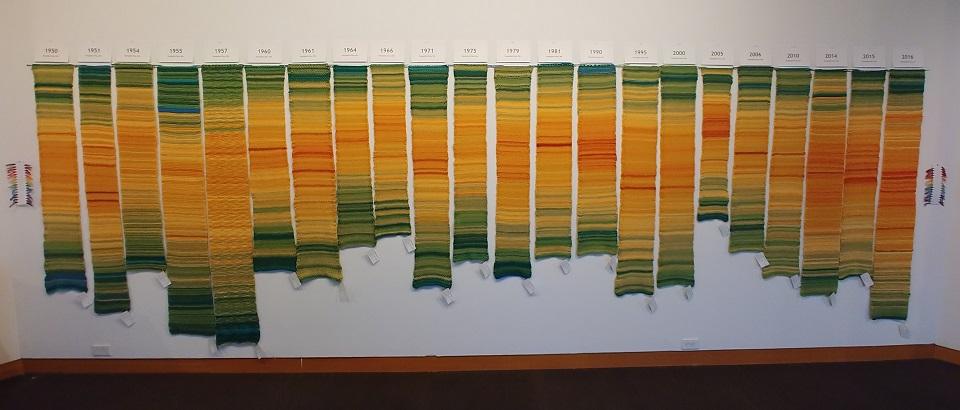
The Deception Pass, Washington, Collection ranging from 1950 to 2016, exhibited at the Museum of Northwest Art/Photo courtesy of the Tempestry Project.
Large Scale Fiber Projects
Combining fiber art and data on a large scale is not new.
Spearheaded by Cork, Ireland, in 2005 as part of a year-long "European Capital of Culture," the Knitting Map project recorded daily weather and citizen walking patterns in varying hues of yarn and different textural patterns. Though controversial (the project was misunderstood and expensive) the Knitting Map combined modern data sensors with historic knitting techniques to create a fiber representation of their city, one that could be touched and viewed. Perhaps most importantly, the giant Knitting Map tapestry was created by local women, working together towards a common, crafting goal.
The National Park Tempestry Project
"The power of Tempestries comes from displaying multiple projects together. Doing that for scores of National Parks will emphasize the urgent message of climate change even more." - Beth Remhof
I completed my first Tempestry for the Hubbard Brook Experimental Forest in the White Mountains of New Hampshire, but couldn't stop thinking about the relationship between changing climate and the fate of our national parks. Already warmer temperatures are impacting montane species that need the cold; are shifting gender ratios of sea turtles nesting on our shorelines; are changing flood and fire regimes. What if a wide-ranging project could showcase not only the natural beauty of the parks, but how they changed differently through time?
A little nervous, I reached out to the Tempestry folks - what did they think of a National Park Tempestry Project?
Luckily, they had meaningful experiences within the national parks long before I approached them. Emily has "very fond childhood memories of summers spent driving up and down the West Coast, visiting the redwood forests and the Olympic Peninsula." Additionally, her parents love the national parks and plan to visit as many as possible during their retirement. She writes: "My mother in particular, both a lover of the parks and an avid knitter and cross-stitcher, is completely enamored with the National Park Tempestry Collection."
Justin recently visited the Manhattan Project National Historical Park's Hanford Reach site: "Despite the horrors of the time, it's an impressive monument to what humans can accomplish - for good or ill - when we take action together. It has solidified my belief that a global mobilization reminiscent of the United States' WWII mobilization of the public and private sectors is the best, and maybe only, hope for mitigating the impending climate catastrophe."
After I emailed them to sketch out the idea, they responded both immediately and positively. We worked out the general guidelines for the National Park Tempestry Project: each knitter, crocheter, or cross-stitcher would select one site, but complete two Tempestries. The first would be from 2016 - the National Park Service Centennial - the second would draw from the oldest data available. Because the team tries to use NOAA data whenever possible, the oldest data can range widely depending on the region of the country.
"We were absolutely delighted with the idea, and continue to feel that way as it takes shape," they write, "What a brilliant way to connect climate and environmental awareness to a practical, hands-on, much-cherished part of America - our public lands, protected, and visited by and for millions of Americans every year."
I posted the sign-up lists and descriptions on the Tempestry Facebook group, hoping for a few initial responses.
The sign-ups have blown us away.
In just a few weeks, more than 40 knitters have signed up for a national park site - nearly halfway to our initial goal of covering 100 national parks under the Tempestry Project initiative. As for me, I claimed Gulf Islands National Seashore, the park I am most familiar with and close to my home and heart.
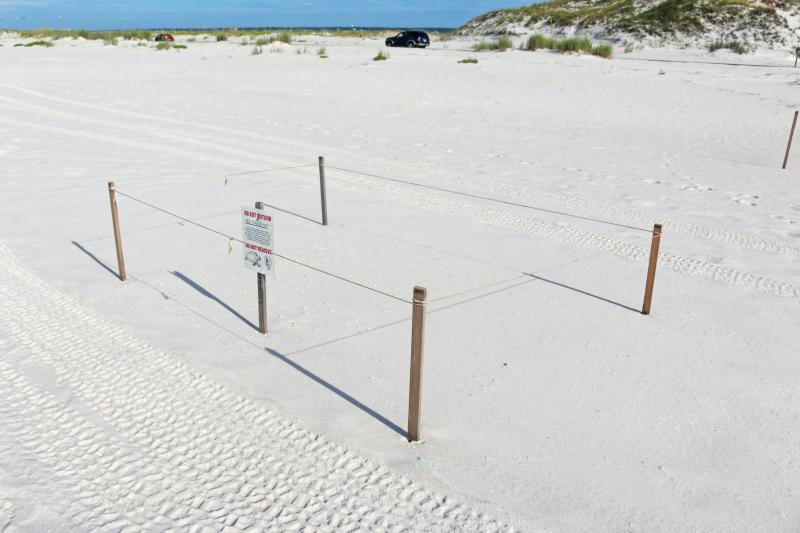
Sea turtle nest at Gulf Islands National Seashore/Erika Zambello.
Others chose their sites for a variety of reasons.
"Part of my park (the Manhattan Project National Historical Park) is the small city where I live," explains Allison Wolf of Tennessee. "There's, understandably, a lot of focus on what happened here, and not as much focus on the natural world around us. Climate change affects all of us, including those of us in more settled areas, and I'm interested in bringing that message home."
Laura Lawrence-Mobbs of Washington drew on the same sensibility when she says, "I grew up in southeast Alaska and in many ways it’s still very close to my heart. It appeared no one had signed up for any of them so that’s why I chose the ones I did."
Still others chose parks where they had worked. Nancy Lowe of North Carolina worked as a volunteer in Great Smoky Mountains National Park with the All-Taxa Biodiverstiy Inventory, "doing some field work and some scientific illustrations," and is now signed up to complete two Tempestries.
In addition to connecting them to specific locations and time periods, the Tempestries make each knitter feel something as they work. The process is as important as the product. For example, Laura Amundsen writes: "I look forward to thinking back to the fun times I had at the (Great) Sand Dunes (National Park) - like Senior Sneak Day, crazy dates, swimming in restricted areas, etc., etc., etc. It was a different time, but I will think of it fondly as I knit away!"
Elise Anderson from Colorado also appreciates the techniques involved in creating each Tempestry: she writes that she is looking forward to "the colors, yarn, my hands in a new project. Doing a new technique. Oh and beads!" she adds, "And on top of that doing something good, showing climate change!"
Despite their experience with the positive reception of Tempestries in general among the crafting community, the Tempestry Team was surprised by the level of interest: "Clearly this particular iteration of the Tempestry Project resonates deeply with people," they write, "It expands on the idea of a collaborative, communal, shared project - so many of us have a personal connection to the national parks, and it seems like people really jumped at the chance to both honor their favorite parks and use them as a means of honoring the work we are all collectively doing."
Moving Forward
Emily's "call to action and realization of such a tangible, visible piece of history is powerful to me, and this history-making is important in my lifetime." ~ Jessica Campbell, Washington.
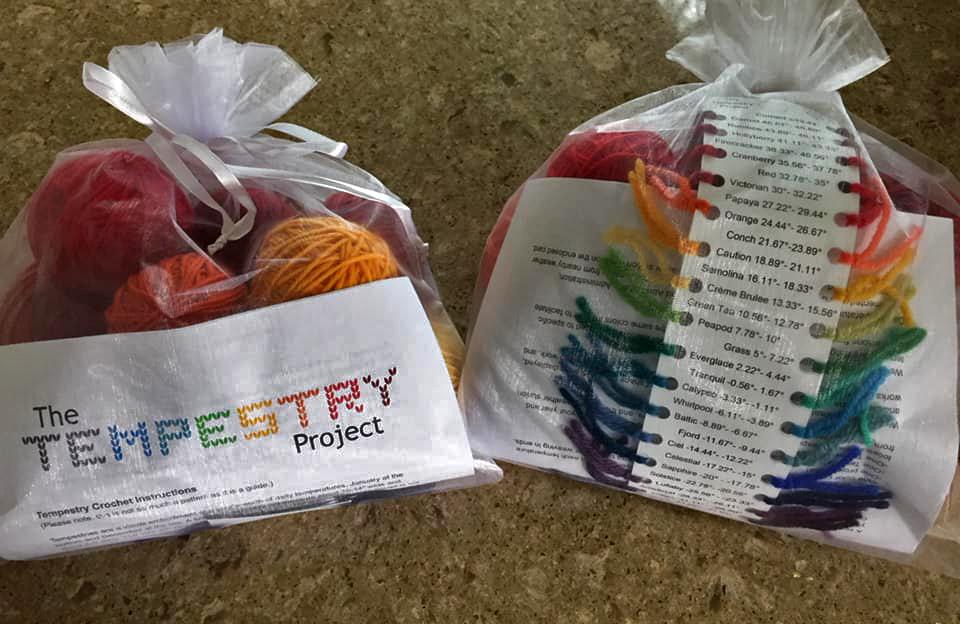
A new Tempestry kit arrives in the mail/ Loren Gmachl.
The government shutdown slowed the Tempestry process, as NOAA restricted access to the databases the team uses to create the different patterns for each location. In March, the first of the national park tempestries began arriving on crafters' doorsteps, waiting to be transformed into a fiber art and science installation. Over the next six months to a year, knitters, crocheters, and cross-stitchers will create Tempestries for their chosen park, taking in-progress photos as they go. Once complete, each tempestry duo will be photographed within the park, highlighting not only the data but the vast diversity of the parks themselves. The Tempestry Team continues to produce the kits needed for each site, while I have spearheaded the logistics of signing up crafters, organizing the upcoming photographs, and curating the final collection of images and tempestries.
While process and community are critical, the end product draws the most knitters in. Loren Gmachl of California writes that she is looking forward to "seeing what the differences are between the 1916 tempestry and the 2016 one. Since my passions are fiber, national parks, climate change, and birds, this combines three of my four interests into one (and we can probably put the birds under national parks since it's all part of nature)."
As for the Tempestry Team, "We would love to see a photography collection, whether as an exhibit, a book, or an online gallery of the finished Tempestries in their respective parks," says Emily, Justin, and Marissa. "And we would love for the whole process to help reconnect people with the idea that publicly-held lands are to be enjoyed and cherished and protected."
Perhaps Laura Patterson of California sums it up best when she writes: "I just LOVE knitting Tempestries. I love that nature creates the pattern and tells the tale. I'm a conservation biologist and an avid knitter and a lover of places protected for their natural and cultural resources, so being able to share so many of my passions in a way that is also part of something bigger is just so exciting. I'm just going to keep looking for parks to do as I finish one."
Stay tuned for a halfway point update on the National Park Tempestry Project, including photos of the first finished works!


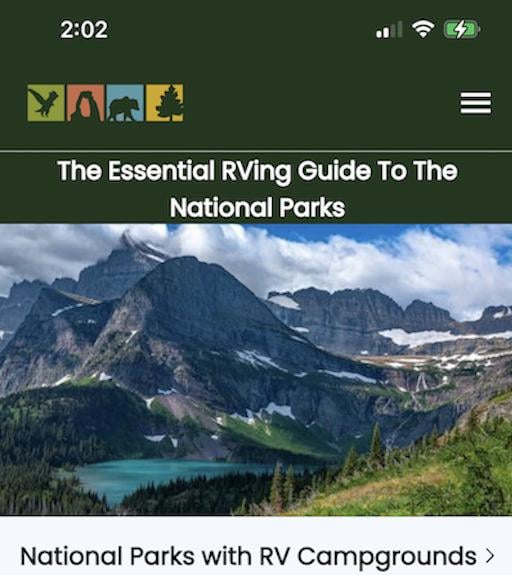
Comments
I like to think I'm the biggest National Park fan of all time, so the idea of contributing to this project is irresistible!! I've already made two pairs of Tempestries (for Carpinteria, CA and Ladakh, India-Himalayas) so I'm familiar with the power of this project. It's a brilliant way to get a hands-on and visual, visceral, understanding of climate change in our most precious places. Sad and startling, important and necessary. Let the knitting begin!
i must of been in a dark hole. I just heard about this from a flosstube, Jan Hicks, how do you find out if a Park is being represented?
I saw Jan's video just now too. There's a link on her blog. And that takes you to the national park kit purchase page. And on that page, it says Here is an up-to-date list of spoken for National Parks as well as a few FAQs about this collection." If you click the bold, darker section, it takes you to a google doc that shows what's been claimed. You can also email them from the page in her blog. I'm sending them an email now since i need a bit more information. I didn't see a deadline for one.
I am a huge lover of the National Parks, having hiked multiple parks over the years. There is a saying regarding the weather, if you're having normal weather that's abnormal. Lefties have gone from calling it Global Warming to now Climate Change to whatever suits their cause. So if the US gives up on the oil and coal industry, putting millions of high paying jobs and Americans out of work. Does that mean that the biggest polluters like China Mexico and India will follow suit? No they'll just laugh at us...
Brian Green ===
You were fine raving about the parks. When you started partisan ranting, not so much.
Having just returned from a trip that included visiting 6 National Parks and 4 National Monuments, including 2 World Heritage sites, I am more inspired than ever to become involved in the National Parks Tempestry Project. I hope to be able to to crochet a number of tempestries to represent those places which have a treasured place in my family history.
That's great! To work as part of the National Parks Tempestry Project, just email [email protected] and we will give you additional information on how to proceed!
As someone engaged in this project, I want to point out that the project itself is just data visualization. We're not cherry-picking the data here, but you're likely to see a pattern. I'm probably going to add more years for a more comprehensive data set and to see if I can get some of the "important years" for my park that correspond to important park-related historical events. I'm connected enough here that I'm pursuing a display so that visitors and residents can connect with the data in a more meaningful way. We do this with other kinds of science and with history all the time here, and information about the climate should not be an exception just because some people think it's politically charged.